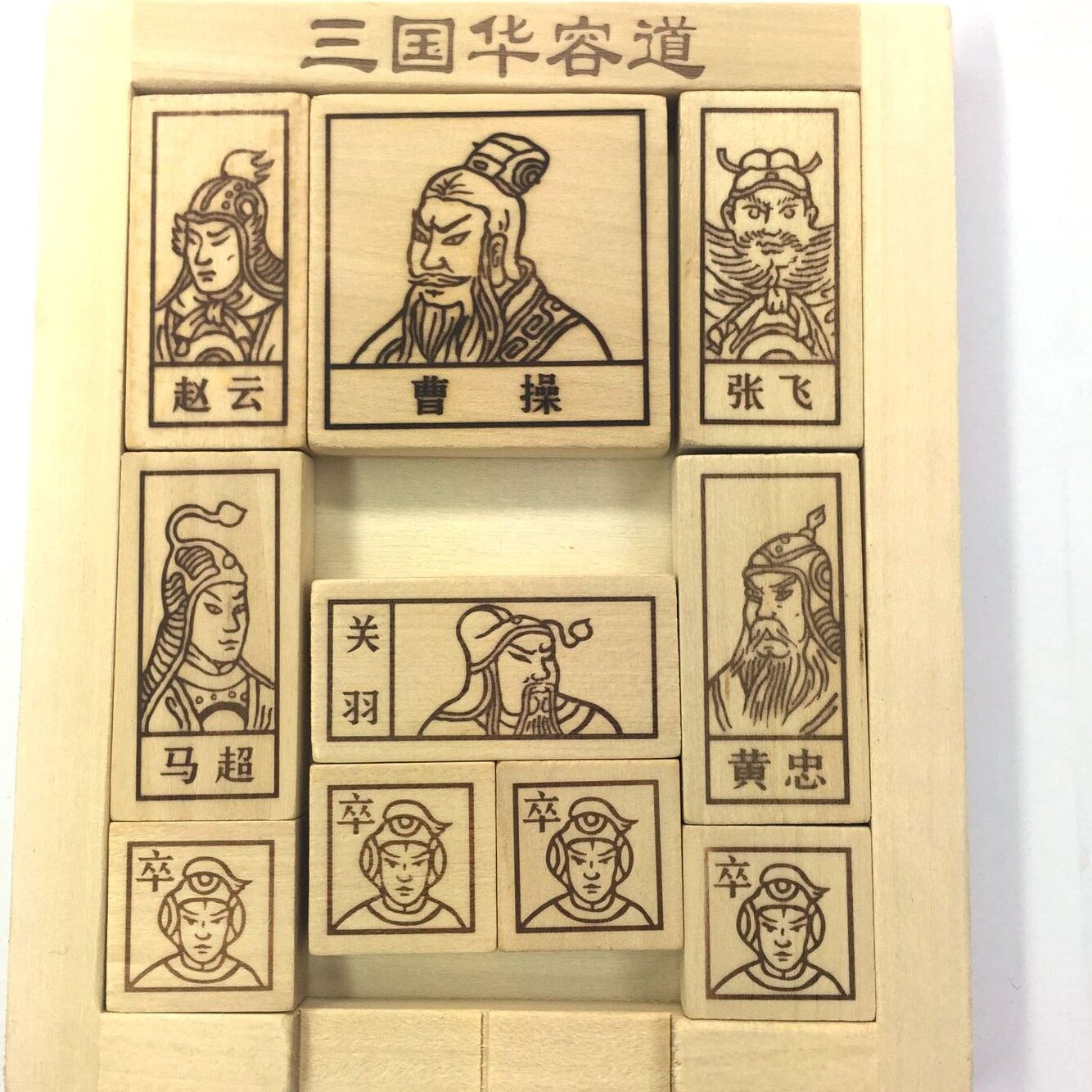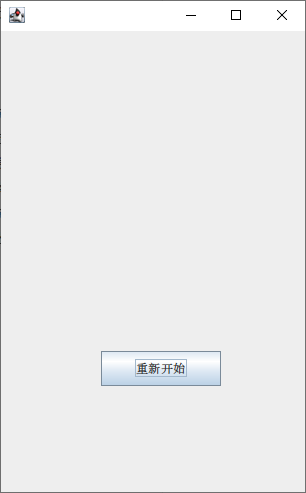利用 Java 的 Swing 编程、事件监听等知识写一个华容道小游戏。这个游戏的作者不是我,但是我根据所学的知识,分析一下游戏的源码,以巩固学习成果。
1 界面分析
华容道游戏的界面如下图所示:

一共 10 个人物,每个人物可以上下左右移动。所以应提前想好一个布局方式,以便在写游戏时设定坐标。

程序所需知识:
- Swing 基础
- Swing 基本组件(
JFrame、JButton) - 事件监听器(焦点、动作、键盘、鼠标)
2 启动类
在 IDEA 中新建一个项目 Klotski,并新建启动类 Start.java 和游戏窗体类 GameFrame.java。根据启动类和游戏主体分离的原则,我们在启动类 Start.java中只新建游戏窗体就行,不做任何与游戏内容相关的操作。
1 | public class Start { |
3 人物类
在设计游戏窗体之前,我们先新建一个人物类 Person.java,这个类用来实例化游戏中每一个人物对象。由于每一个人物对象实际上可以看做窗体的一个按钮,所以使该类继承 JButton 类。
1 | import javax.swing.*; |
我们为人物类设计三个属性,分别是编号、颜色和字体。编号在后期用于定位人物,颜色和字体方便构造人物时初始化。
1 | int number; |
3.1 构造方法
人物类的构造方法要传进两个参数,分别是编号和人物名字,并在下面对编号、姓名、颜色、字体等进行初始化。
1 | public Person(int number, String s) { |
3.2 人物变色监听
当我们想让某个人物移动时,我们需要让其从默认颜色变为别的颜色。这里可以为每个按钮添加一个监听器,并且焦点事件监听器是最适合的。当按钮被聚焦的时候,鼠标键盘也可以对指定按钮进行操作。
可以直接让该类实现 FocusListener 接口,并在构造方法加上焦点事件监听器,把自己传入即可。
1 | public class Person extends JButton implements FocusListener { // 实现FocusListener接口 |
3.3 人物类完整代码
1 | import javax.swing.*; |
4 游戏窗体类
游戏窗体类是游戏的主体部分,包含显示模块和逻辑模块。首先我们让该类继承 JFrame 类。
1 | import javax.swing.*; |
该类首先要有 10 个人物,那么我们实例化一个 Person 数组;以及在属性中添加几个按钮,为边界按钮(处理游戏边界)和重新开始按钮。
1 | Person[] people = new Person[10]; |
4.1 构造方法
构造方法中只写与窗体默认设置有关的部分,具体的按钮布置放到一个初始化方法里面去写。
1 | public GameFrame() { |
4.2 初始化布置
在初始化方法 init() 中,我们一步步放置所需要的组件。首先把窗体设定为绝对布局,并放置重新开始按钮。
1 | public void init() { |
启动 Start.java,查看效果。

接下来放置每个人物。先写一个 String 数组,放置每个人物的名字,再将名字传入本类的属性 people 数组中。
1 | String[] name = {"曹操", "关羽", "马", "黄", "赵", "张", "兵", "兵", "兵", "兵"}; |
设定每个人物按钮的大小和位置。观察第 1 章界面分析中的图,如果设置每个格子的大小为 50 像素 × 50 像素,那么曹操就是 100 像素 × 100 像素;如果游戏左上角的边界为 (54, 54),那么曹操所在的位置应为 (104, 54)。依次类推,设置每个人物的大小和位置。
1 | // 以左上角的位置为(54, 54),每个格子大小为50*50,设定每个按钮的位置 |

再添加游戏边界,游戏边界也可以看做是按钮,我们将这 4 个按钮设定为宽为 5 的长条,并根据添加好的人物的位置确定长条位置。
1 | left = new JButton(); |

4.3 人物移动操作
写一个 go() 方法,使人物进行上下左右移动。传进去的参数肯定是人物和方向,人物放 Person 类对象就行,方向其实把已有的 4 个边界按钮放进去就行了,因为它们就代表上下左右,并且可以直接拿它们的边界。
1 | public void go(Person man, JButton direction) { |
我们的操作判断分为以下几步:
- 先试着移动一下,获取移动后的位置
- 看是否与其他人物的位置或游戏边界的位置相撞
- 如果相撞,则不移动;否则进行移动
先试着移动一下,为了方便判断相撞,我们先拿一个矩形类 Rectangle 放这个人物的边界,并获得坐标。
1 | Rectangle manRect = man.getBounds(); // 人物边界矩形 |
再试着移动一下,这里我们只操作 x 和 y,所以人物、矩形都是实际上没有移动的。
1 | if (direction == above) { |
再把矩形移动过去(人物还是未动)。
1 | manRect.setLocation(x, y); |
从这时开始,我们要进行判断,先建立一个布尔型变量 move 并初始化为 true,并拿矩形类 Rectangle 放其他人物的边界、游戏边界的边界,使用 intersects() 方法判断是否相撞。
1 | boolean move = true; // 移动判断变量 |
再根据 move 的结果,对该人物进行移动。
1 | if (move) { |
4.4 游戏重启监听器
点击重新开始按钮,游戏重启。我们让本类实现 ActionListener 动作事件监听器接口,并在 init() 方法中为 restart 添加监听器。然后重写 actionPerformed() 方法,可以直接销毁游戏窗体,再重新新建实例就行了。
1 | public class GameFrame extends JFrame implements ActionListener { // 实现ActionListener接口 |
4.5 键盘操作监听器
键盘是可以操作人物的移动的。我们让本类实现 KeyListener 键盘事件监听器接口,并在 init() 方法中为每个人物添加监听器。
1 | public class GameFrame extends JFrame implements ActionListener, KeyListener { // 实现KeyListener接口 |
我们只需要重写 keyPressed() 方法。先拿到键盘事件资源(当前聚焦的人物)和键盘按键,并指挥人物按一定方向移动。
1 |
|
4.6 鼠标操作监听器
鼠标不仅可以聚焦人物,也可以操作人物移动。我们让本类实现 MouseListener 鼠标事件监听器接口,并在 init() 方法中为每个人物添加监听器。
1 | public class GameFrame extends JFrame implements ActionListener, KeyListener, MouseListener { // 实现MouseListener接口 |
我们只需要重写 MousePressed() 方法。先拿到鼠标事件资源(鼠标点击的人物)和鼠标坐标,再拿到这个人物的边界大小,根据这个鼠标点击的位置(如点击人物上半部分,则向上移动),指挥人物按一定方向移动。
1 |
|
注意,键盘事件和鼠标事件不用 else-if,可以让人物斜向运动,运动顺序由程序书写顺序决定。
4.7 游戏窗体类完整代码
1 | import javax.swing.*; |
5 扩展与总结
- 步数统计: 可以新写一个属性
step,每go()一次就step++,统计游戏步数。 - 成功判定: 当曹操走到某个坐标的时候,游戏就成功并结束了。
- 不同关卡: 华容道有横刀立马、齐头并前、兵分三路等多种摆放方法,可以只改变人物坐标,实现不同的关卡。
- 记录进度: 把步数、人物坐标存档到文件里,下次可以直接读档,接着来。
- 平台迁移: 把代码换成 JavaScript 版,并写到网页上,游戏基本逻辑是一样的。
这个游戏应该不难,逻辑上没有其他游戏那么多,主要是巩固 Swing 编程的基础。
走了好多遍终于成功了:

